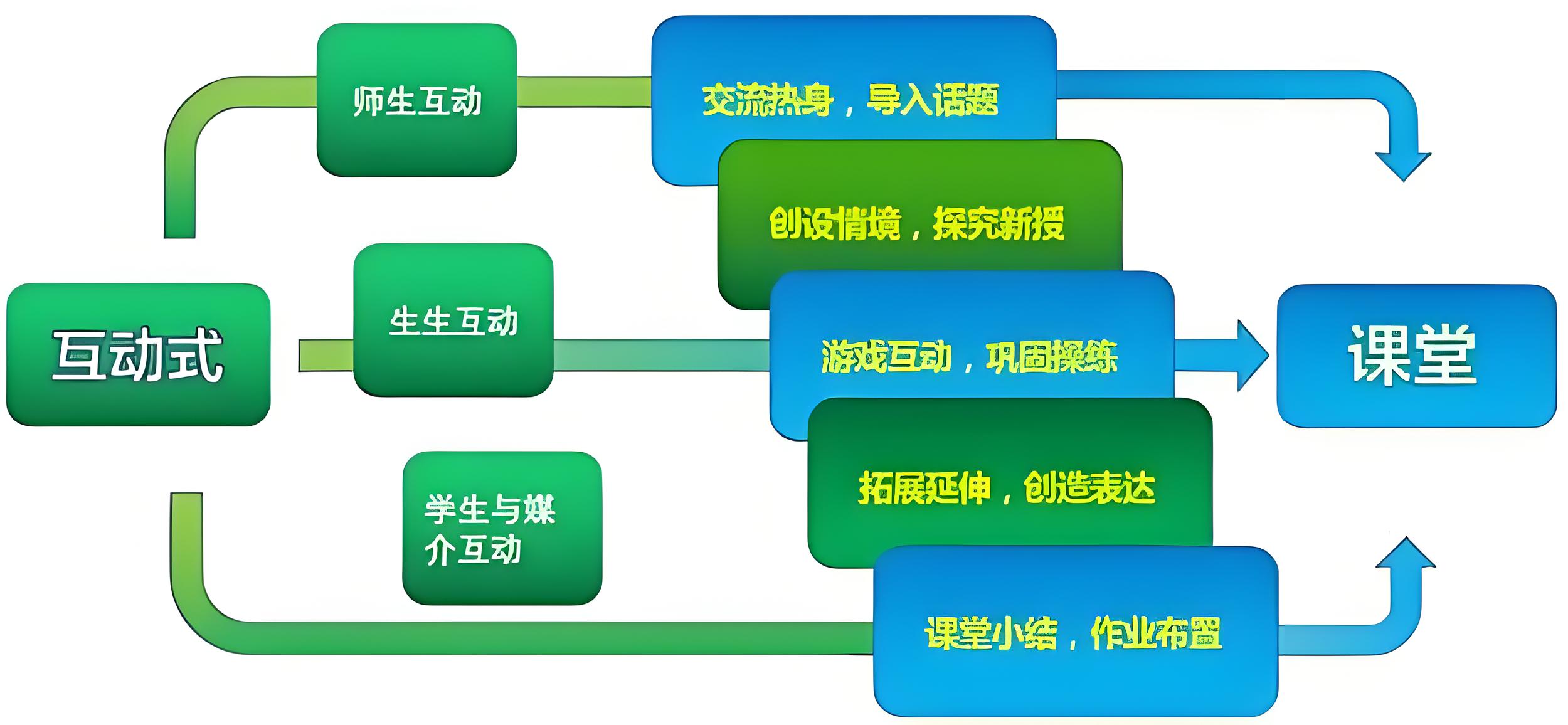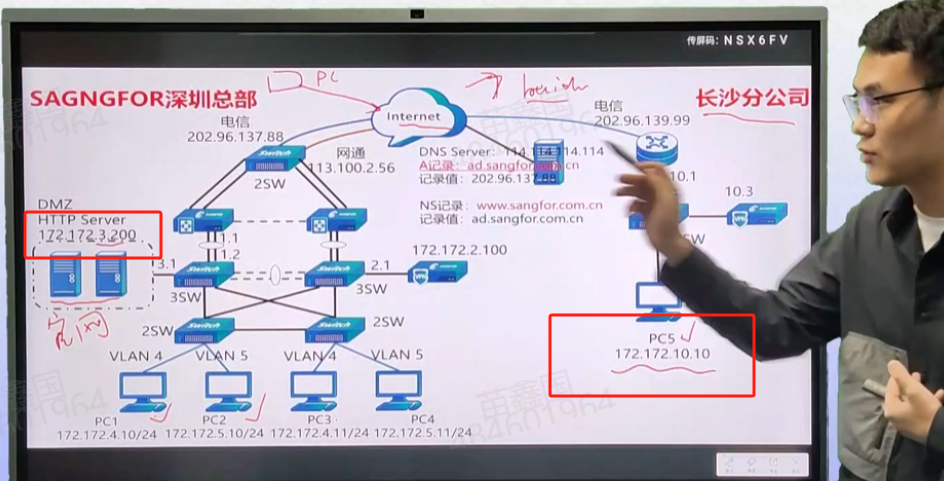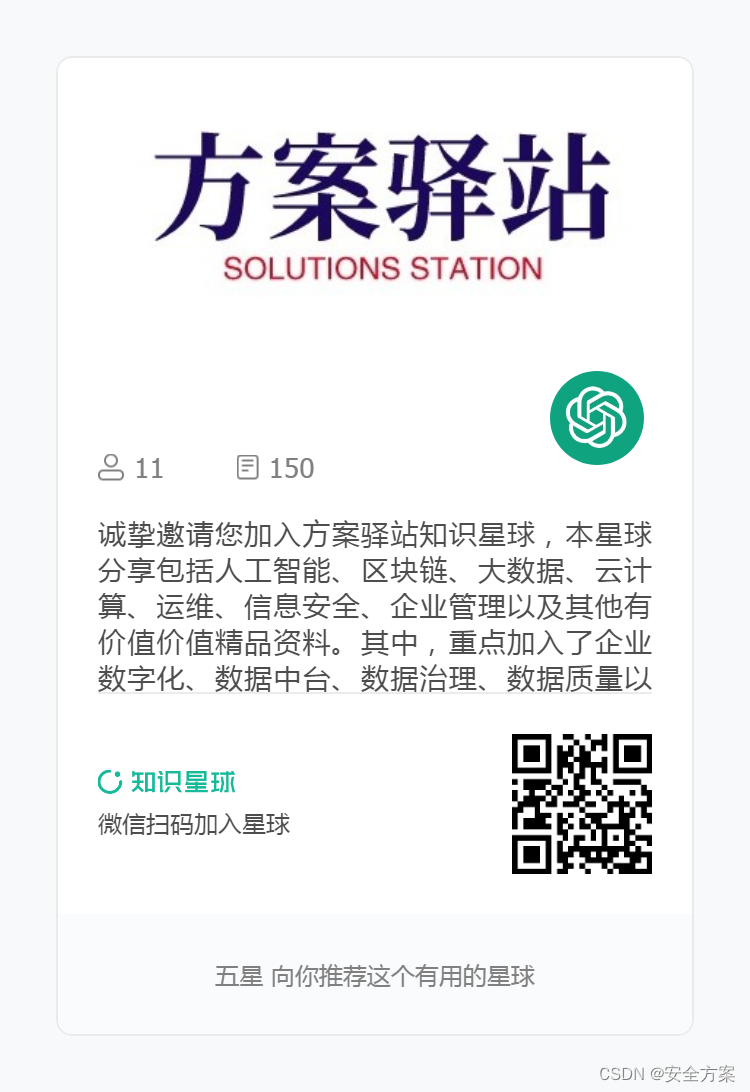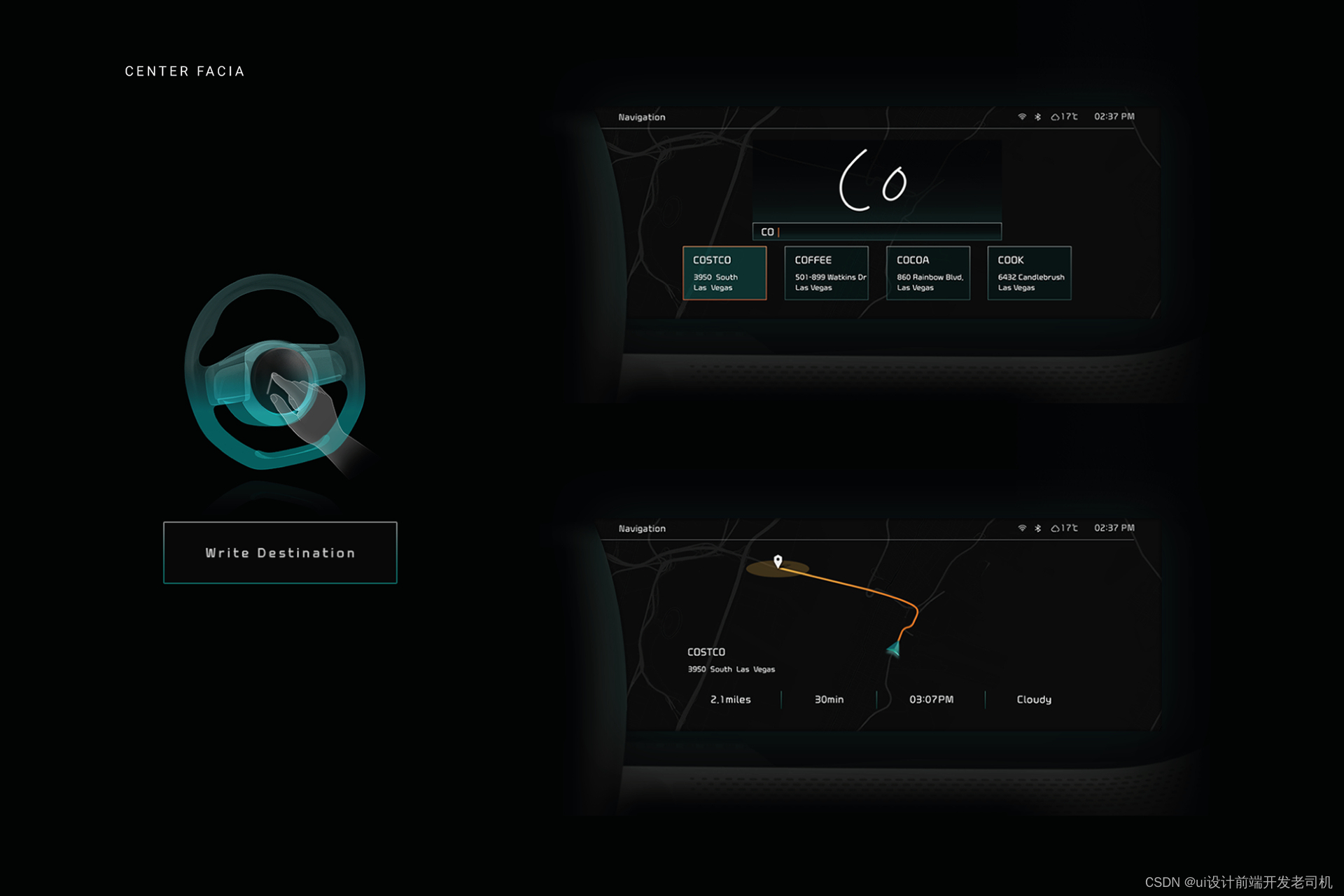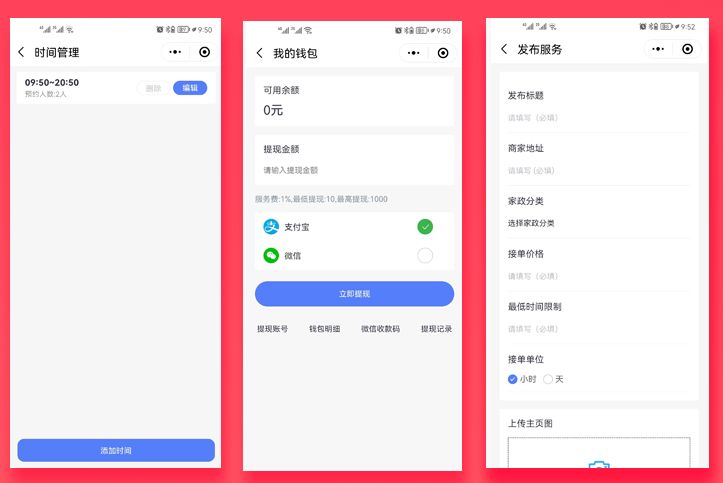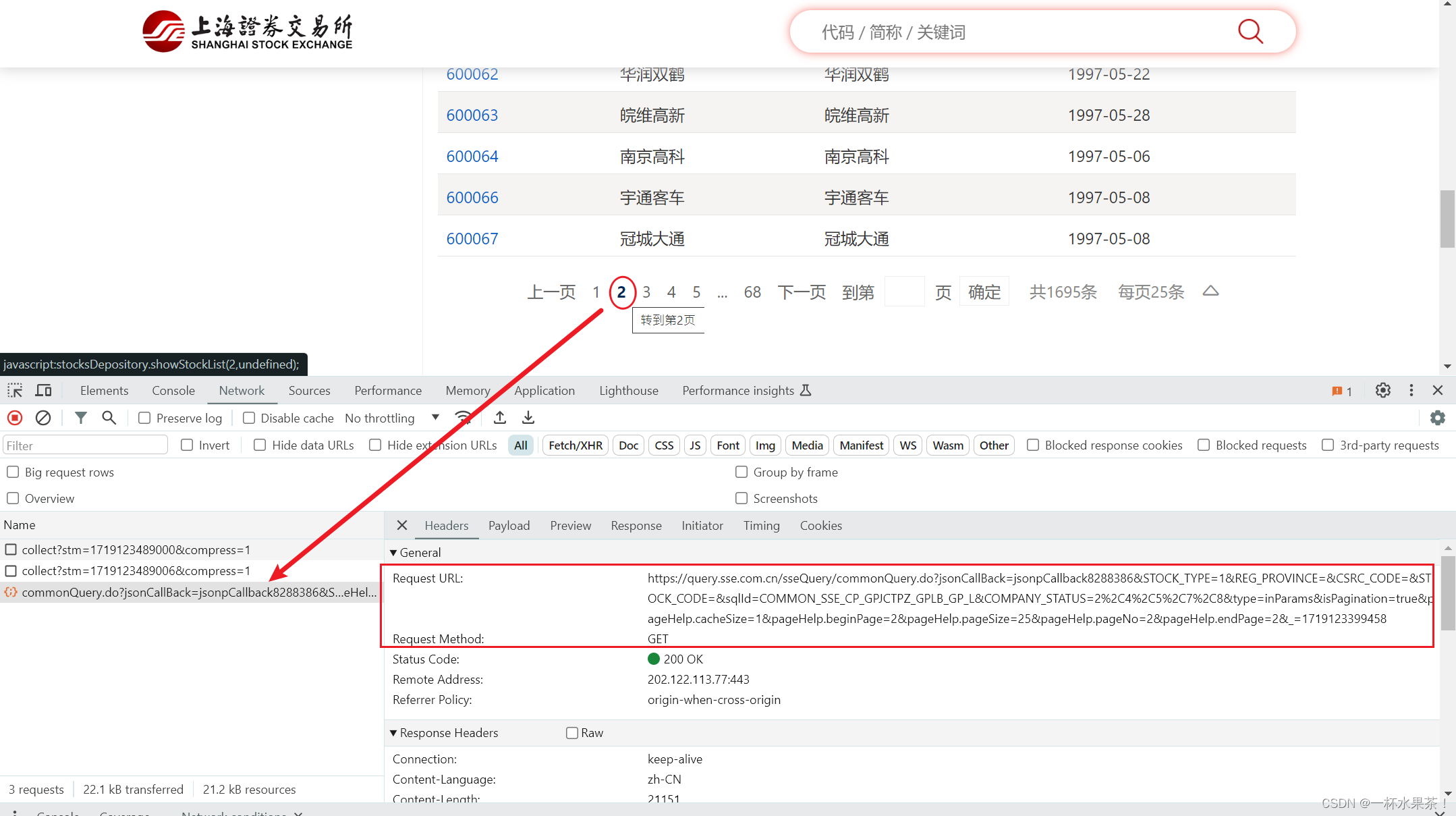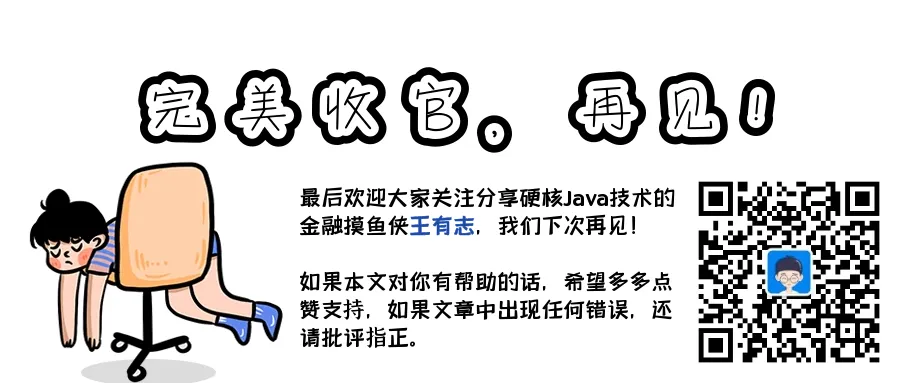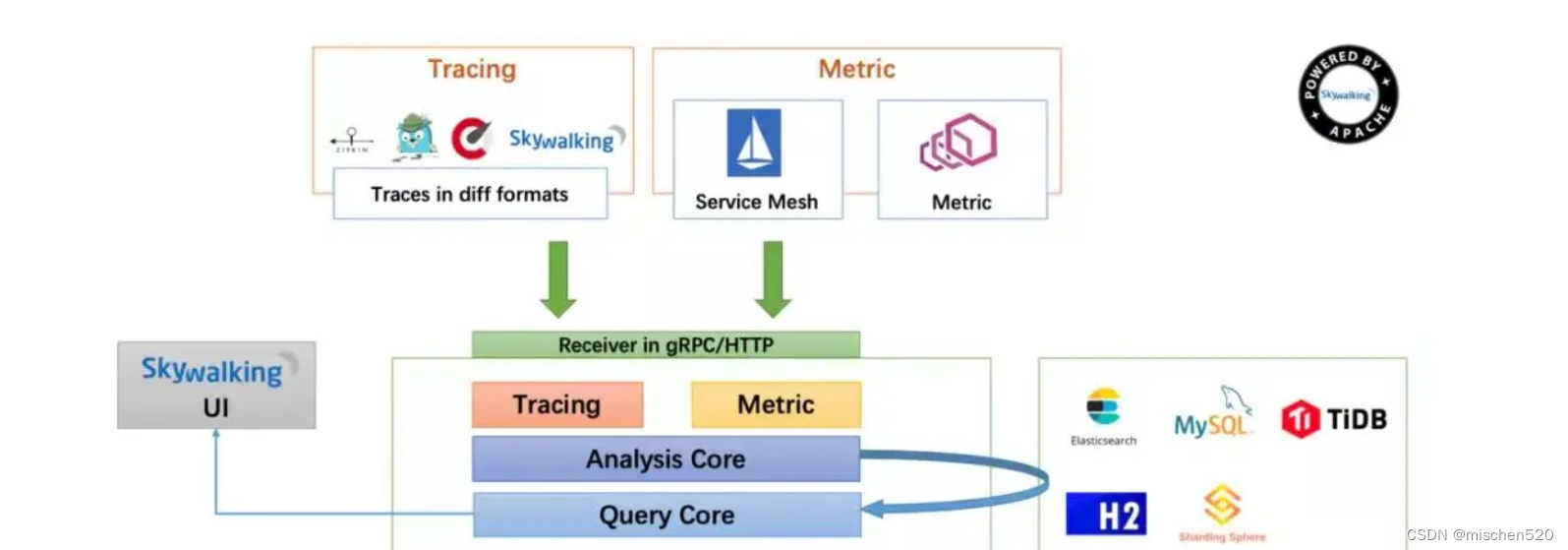目录
一、I2C总线通信协议
1.I2C通信特征
2.I2C总线协议
3.软件I2C和硬件I2C
二、stm32通过I2C实现温湿度(AHT20)采集
1.stm32cube配置
RCC配置:
SYS配置:
I2C1配置:
USART1配置:
GPIO配置:
时钟配置:
project配置:
2.KEil代码配置
添加AHT20文件:
添加路径:
AHT20.c代码:
AHT20.h代码:
main.c代码:
3.实物图连接
4.实验效果
项目代码:
参考博客:
一、I2C总线通信协议
1.I2C通信特征
SCL:时钟线,用于传输CLK信号,一般是I2C主设备向从设备提供时钟的通道。 SDA: 数据线,通信数据都通过SDA线传输
I2C通信时,分为主设备和从设备,其中主设备一个、从设备多个。主设备要主导整个通信过程,从设备根据I2C协议被动的响应主设备; 主设备负责调度总线,决定某个时间和其中一个从设备通信。在同一时间,只有主设备和其中一个从设备通信,其余的从设备处于等待状态,等待主设备与其通信;每个从设备在I2C总线上都有唯一的地址,主设备就是通过地址来区分不同的从设备,从而决定和哪一个从设备通信。
2.I2C总线协议
(1)主设备发送一个起始信号; (2)主设备接着发送8bit数据,其中7位是从设备的地址,一位表示此次主设备是要读数据海思写数据; (3)和主设备发送的地址匹配的从设备发出一个ack响应信号; (4)主/从设备将数据发送到SDA总线上,每次传输都是8bit数据; (5)主/从设备从SDA线上接收数据,并发送一个ACK响应信号; (6)还可以接着n个发送和接收的过程; (7)主设备发送停止信号,停止本次通信;
3.软件I2C和硬件I2C
软件I2C:软件I2C是通过软件控制GPIO管脚来模拟I2C协议的时序。其
1.可以使用任意的GPIO管脚来实现,可适应不同的硬件平台和需求。 2.不依赖于特定的硬件电路,可在不同的平台上进行移植和使用。 3.可在没有硬件I2C支持的情况下使用,也可以用于扩展硬件I2C的功能。
硬件I2C:硬件I2C是通过专门的硬件电路实现的,通常由微控制器或其他集成电路上的硬件模块提供支持。其
1.使用专门的硬件电路,可以实现高速的数据传输。 2.传输过程由硬件电路完成,不需要CPU的干预,因此可以释放CPU的资源。 3.时序由硬件电路控制,不容易受到外部干扰的影响。
二、stm32通过I2C实现温湿度(AHT20)采集
1.stm32cube配置
RCC配置:
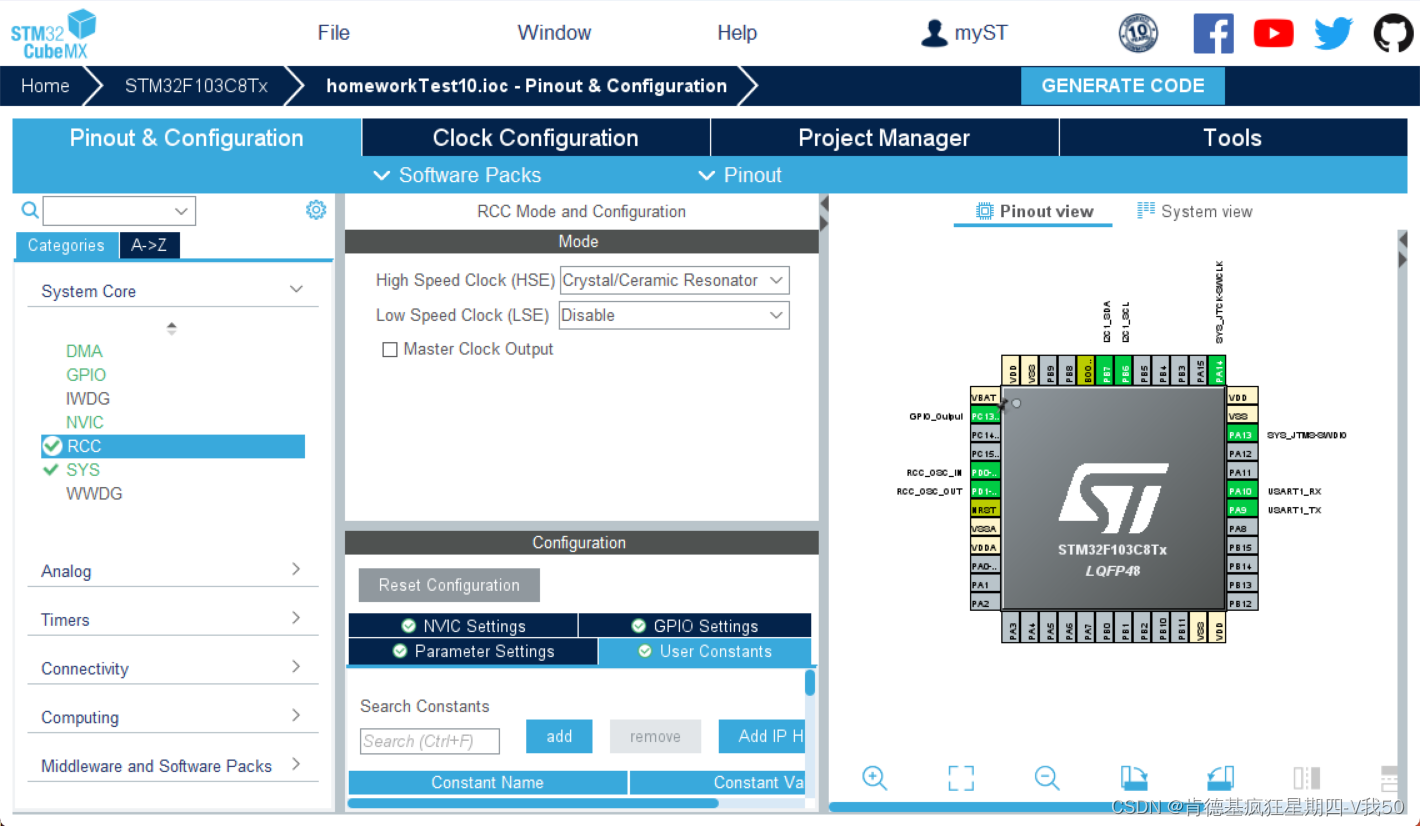
SYS配置:
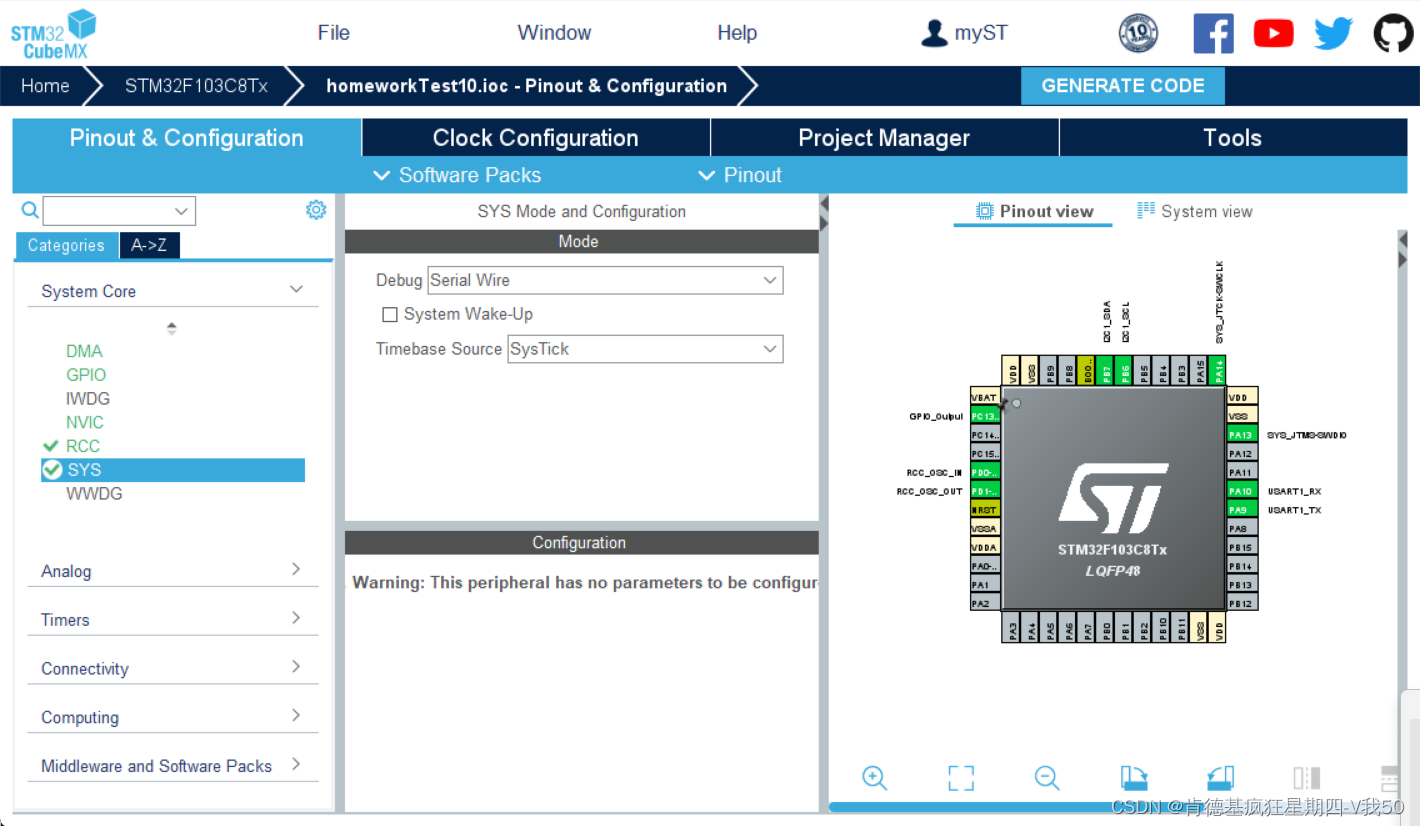
I2C1配置:
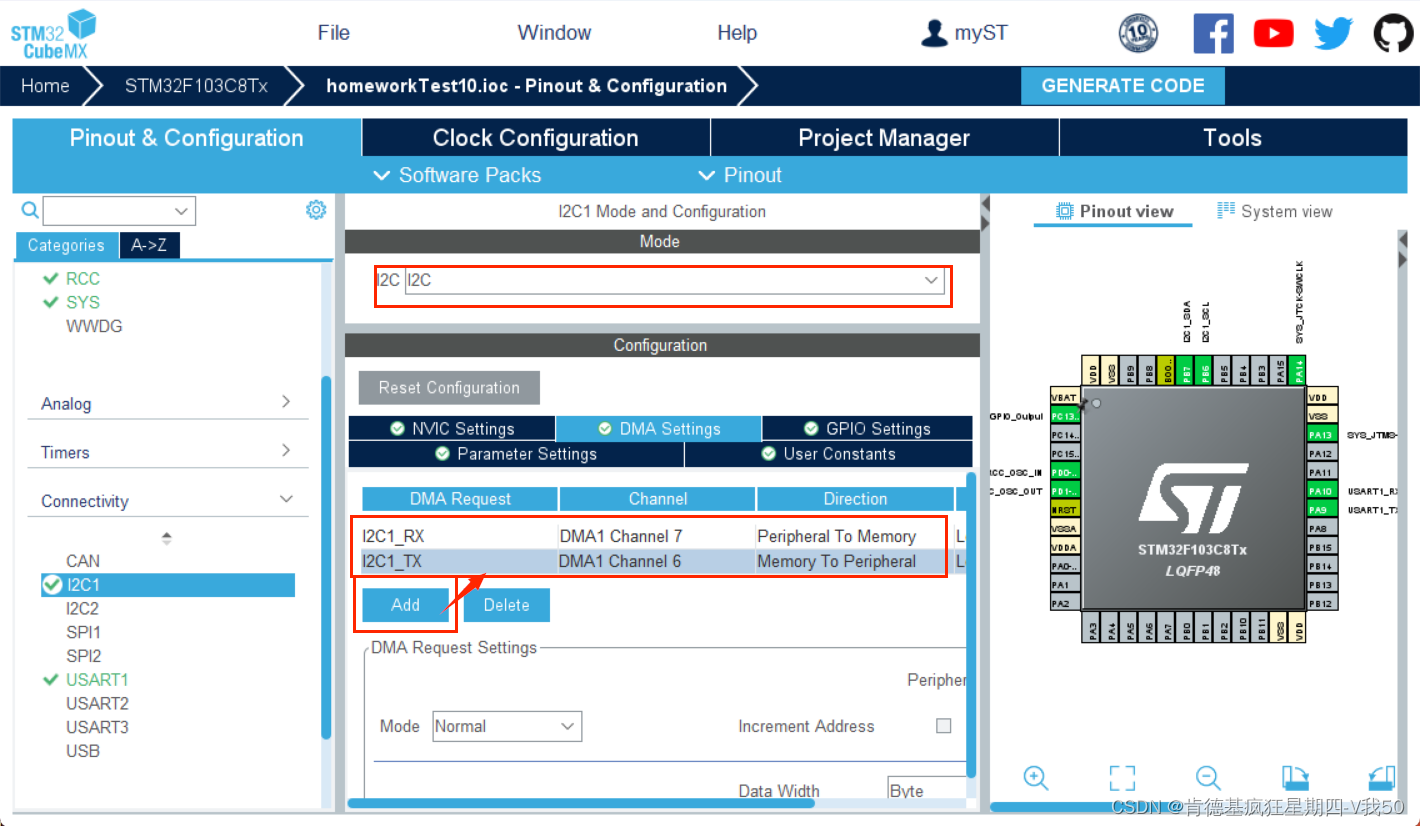
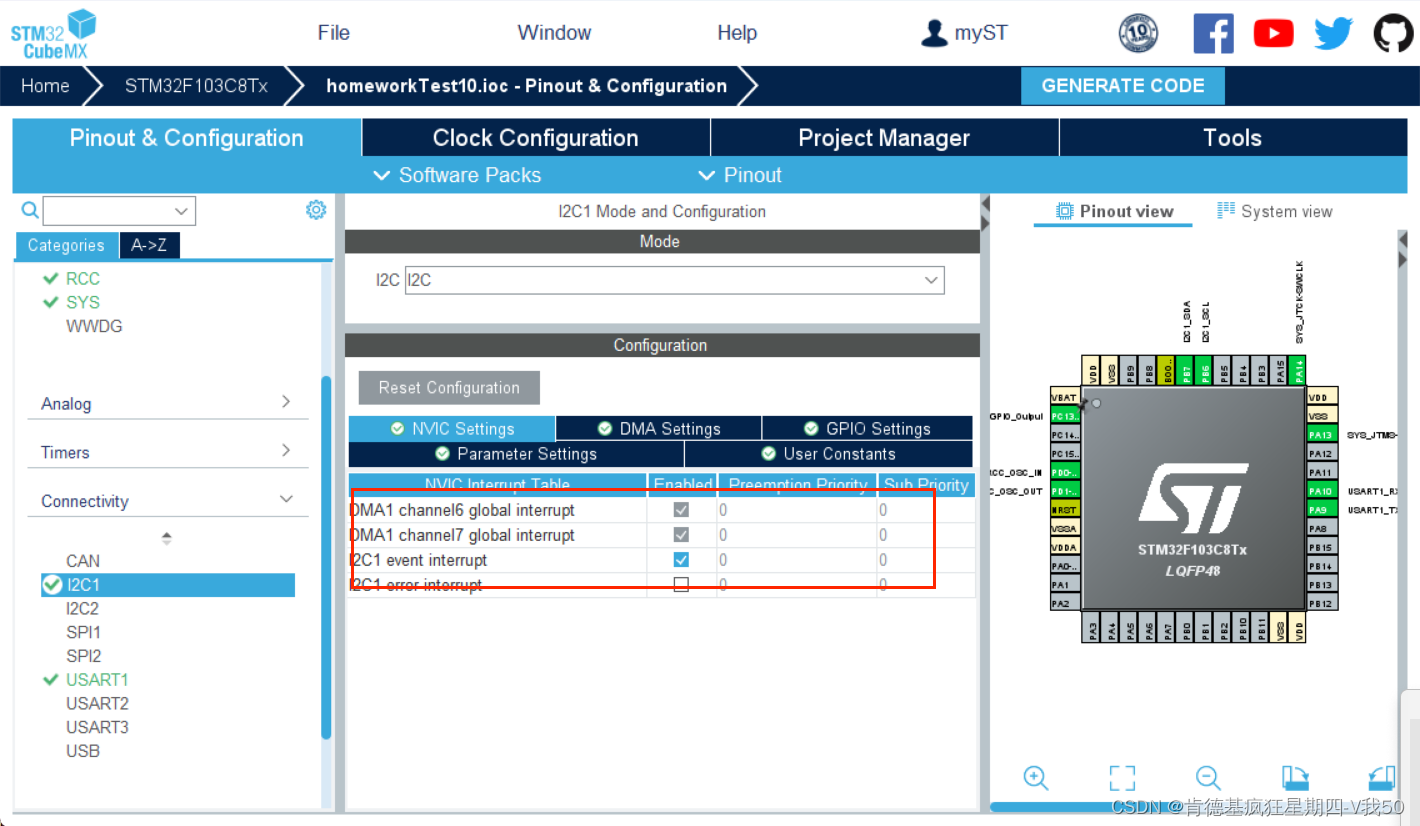
USART1配置:

GPIO配置:

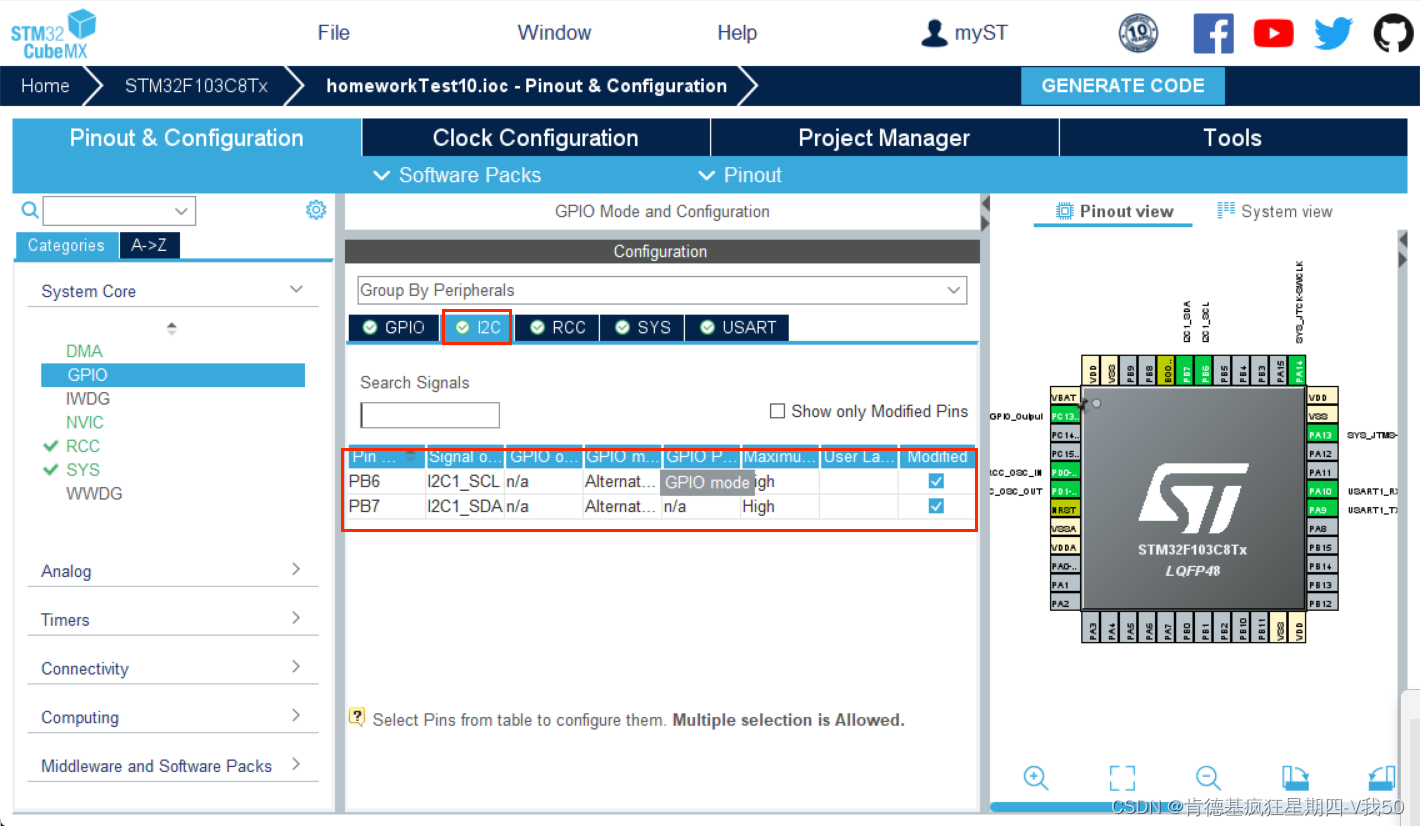
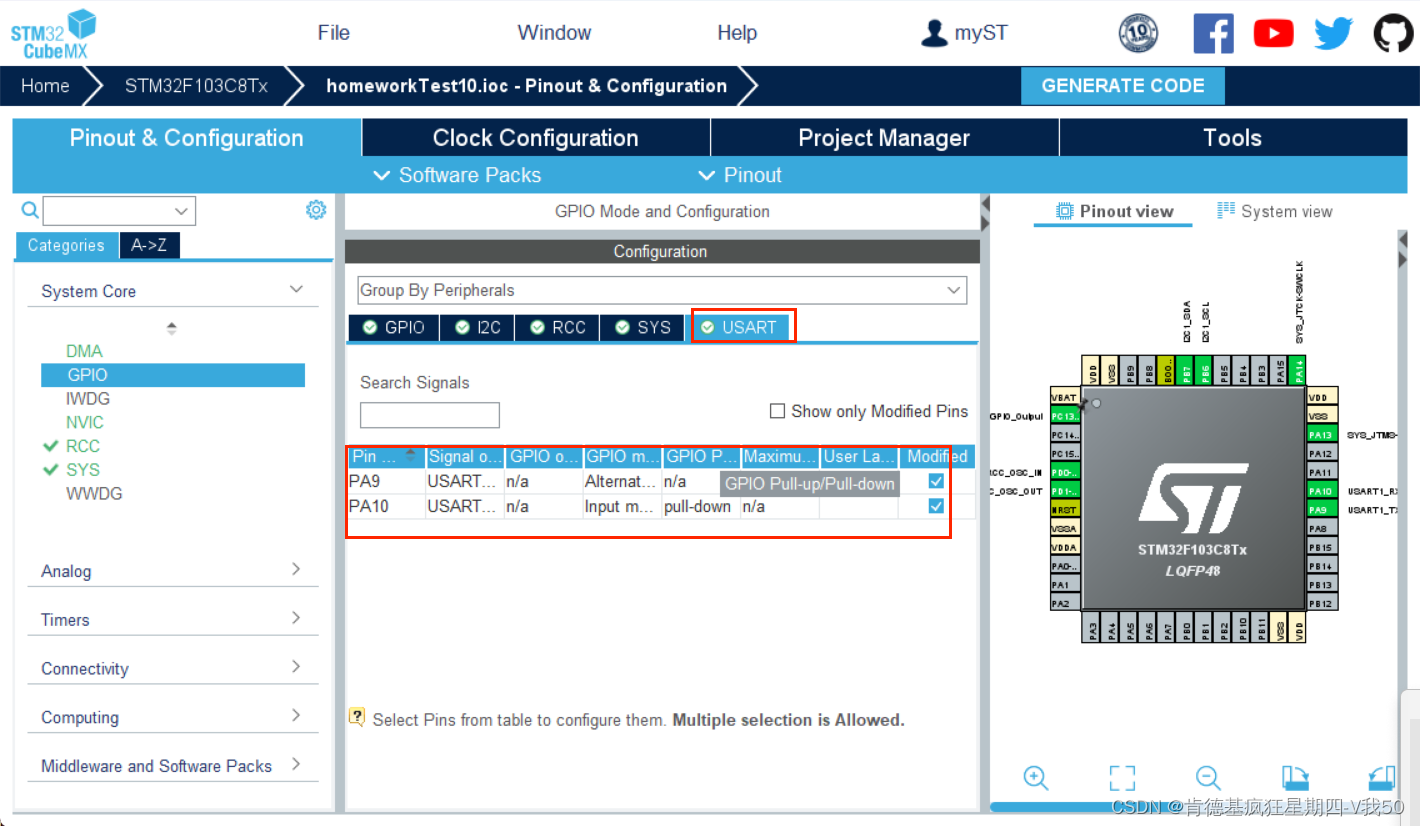
时钟配置:
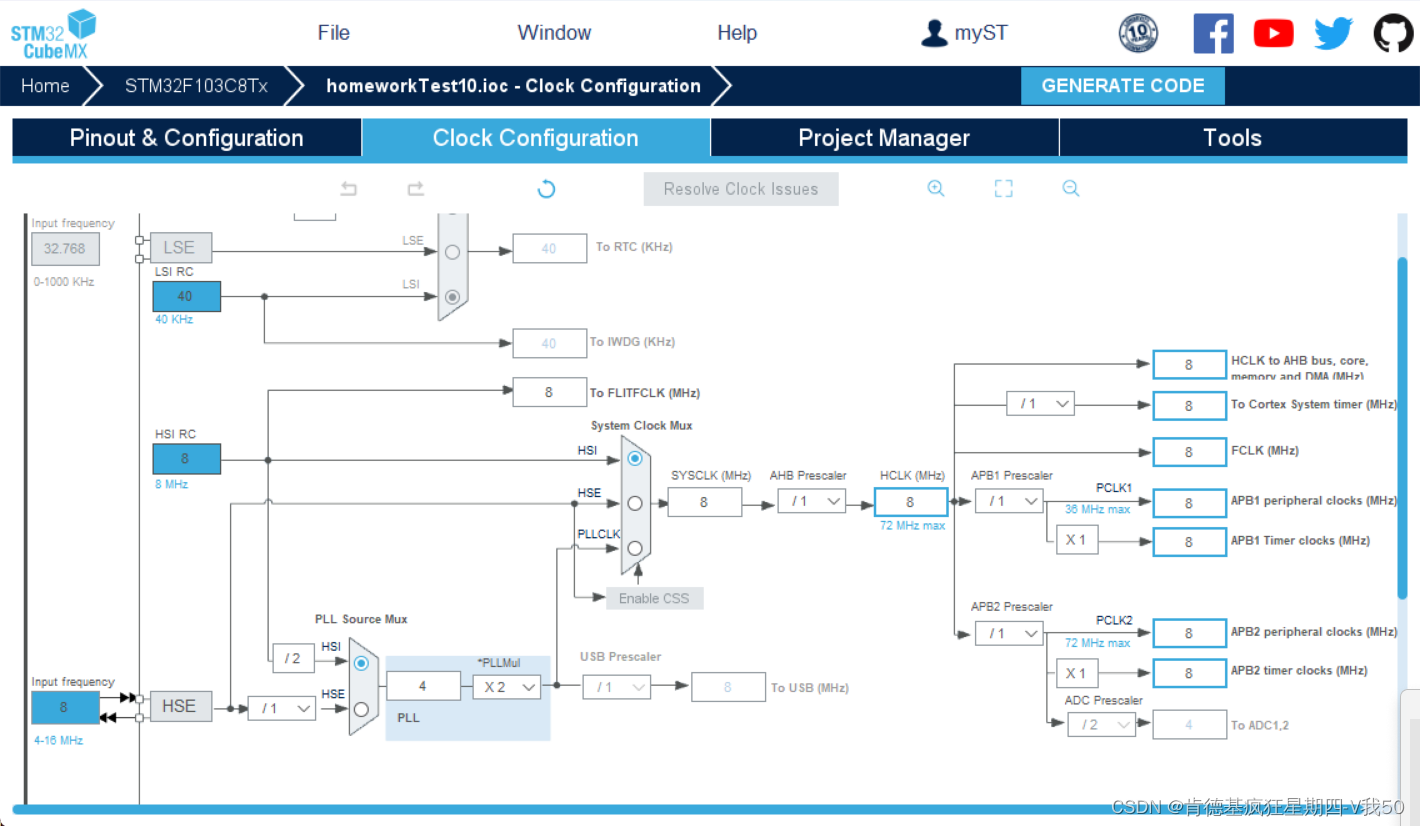
project配置:
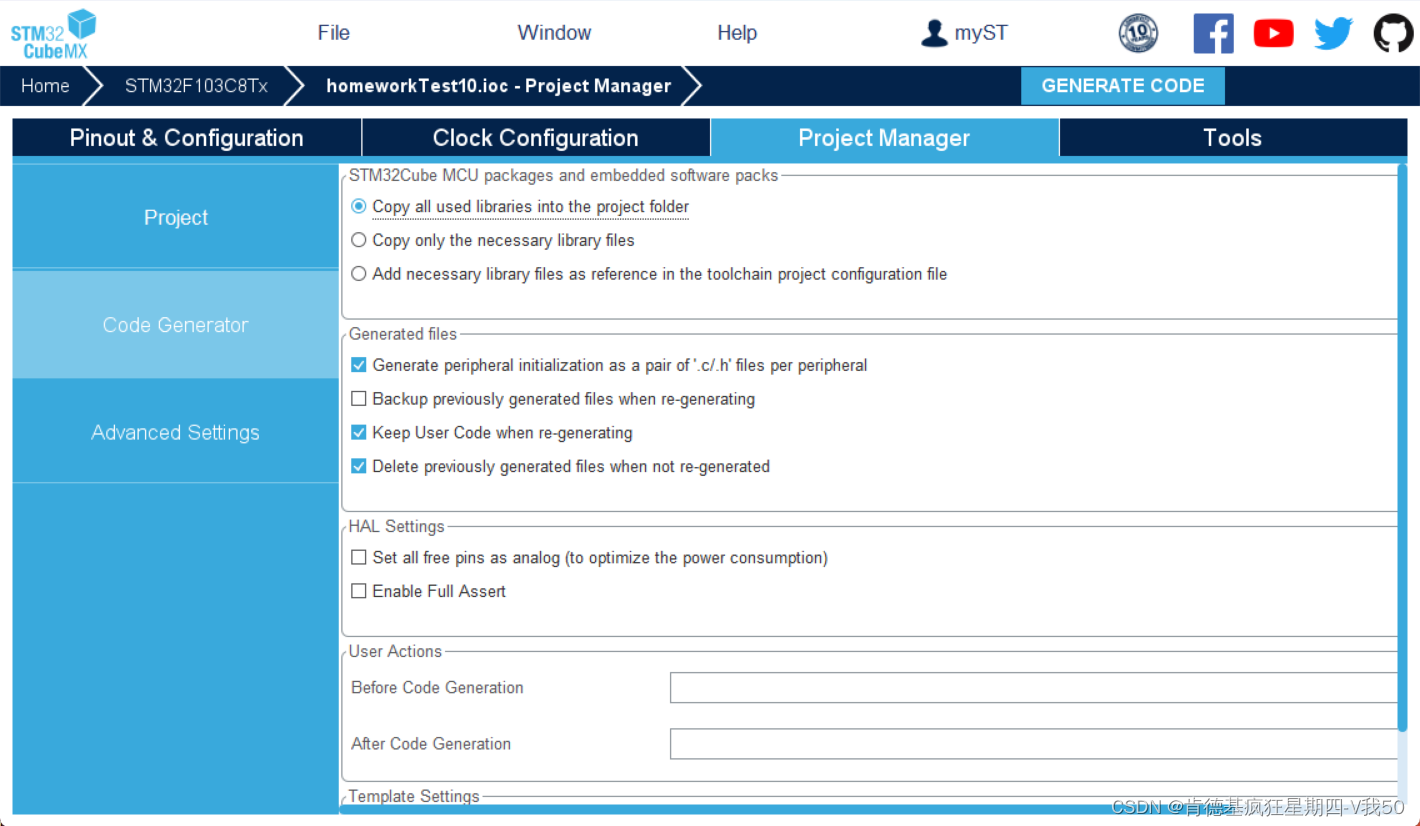
2.KEil代码配置
添加AHT20文件:
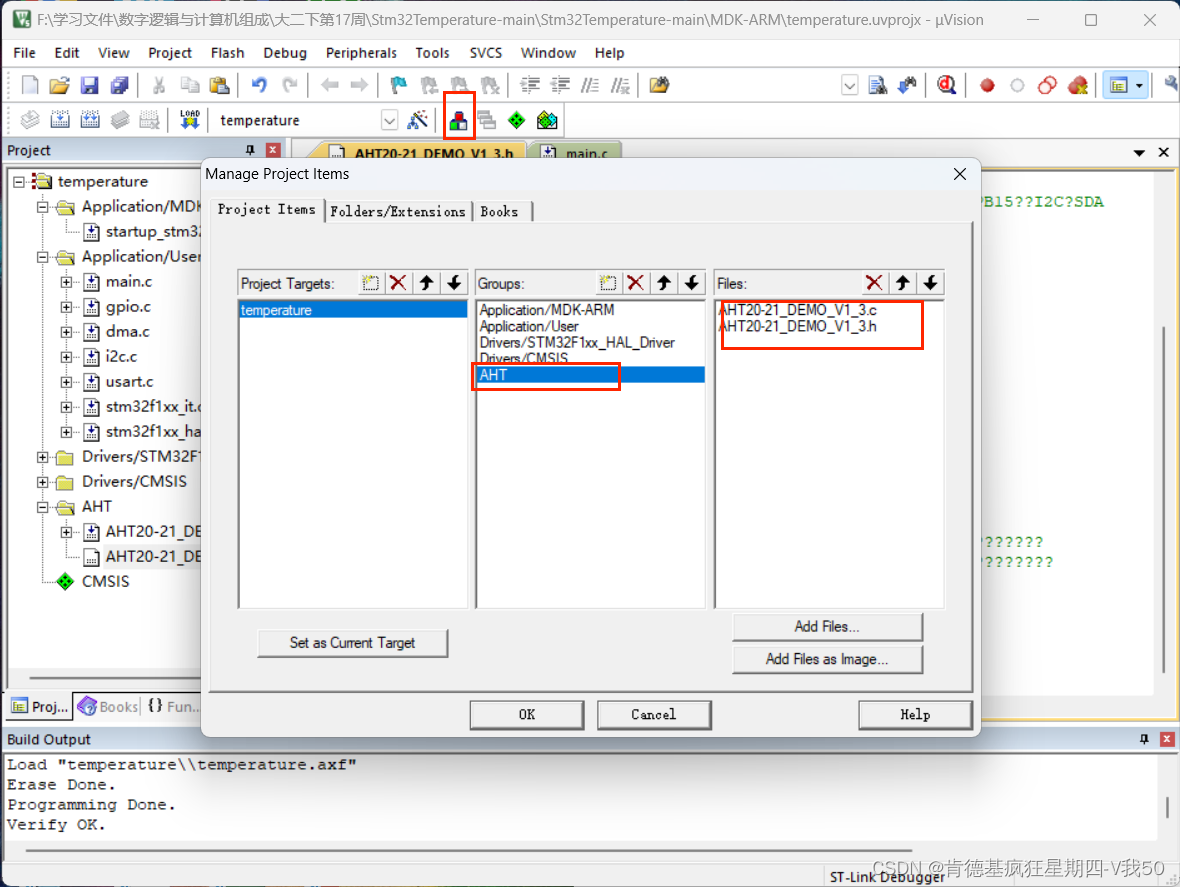
添加路径:
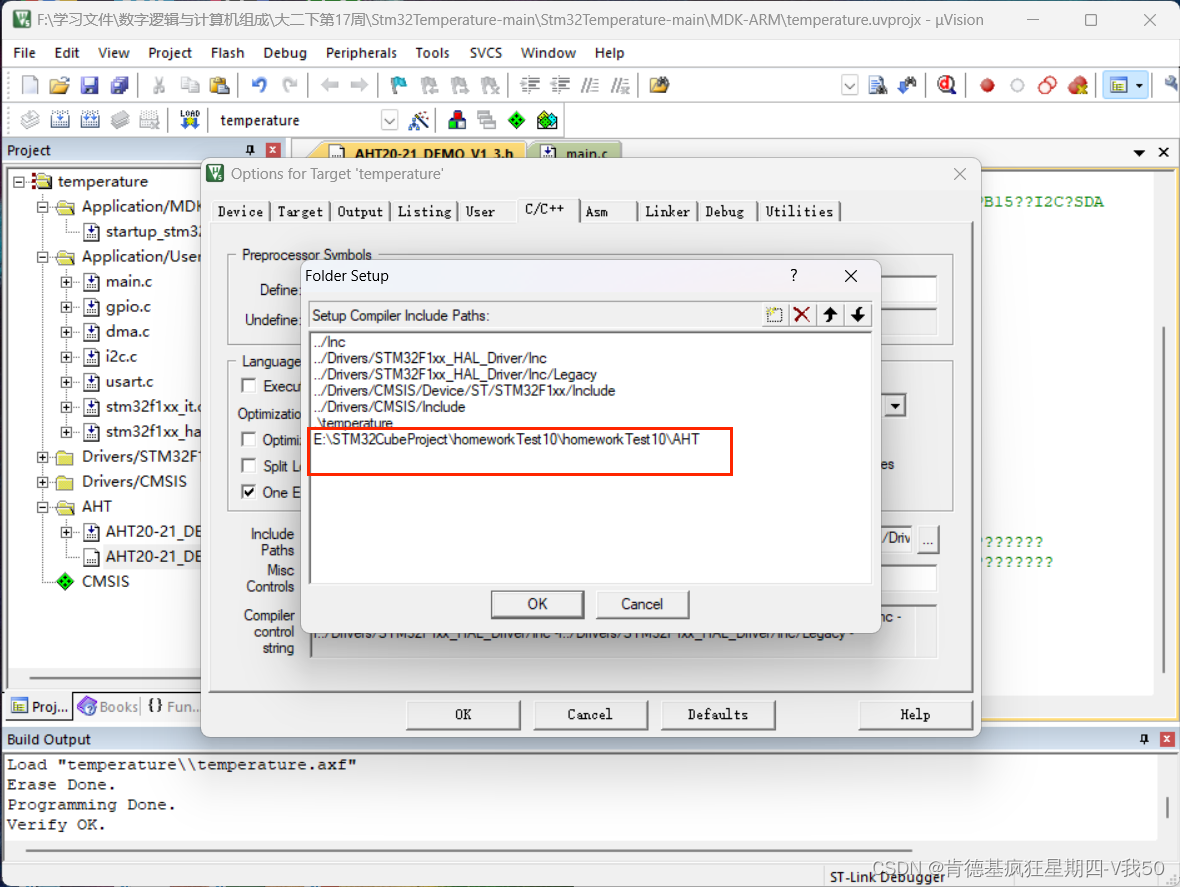
AHT20.c代码:
/*******************************************/
/*@????:?????????? */
/*@??:????????? */
/*@??:V1.2 */
/*******************************************/
//#include "main.h"
#include "AHT20-21_DEMO_V1_3.h"
#include "gpio.h"
#include "i2c.h"
void Delay_N10us(uint32_t t)//????
{
uint32_t k;
while(t--)
{
for (k = 0; k < 2; k++);//110
}
}
void SensorDelay_us(uint32_t t)//????
{
for(t = t-2; t>0; t--)
{
Delay_N10us(1);
}
}
void Delay_4us(void) //????
{
Delay_N10us(1);
Delay_N10us(1);
Delay_N10us(1);
Delay_N10us(1);
}
void Delay_5us(void) //????
{
Delay_N10us(1);
Delay_N10us(1);
Delay_N10us(1);
Delay_N10us(1);
Delay_N10us(1);
}
void Delay_1ms(uint32_t t) //????
{
while(t--)
{
SensorDelay_us(1000);//??1ms
}
}
//void AHT20_Clock_Init(void) //????
//{
// RCC_APB2PeriphClockCmd(CC_APB2Periph_GPIOB,ENABLE);
//}
void SDA_Pin_Output_High(void) //?PB7????? , ???????, PB7??I2C?SDA
{
GPIO_InitTypeDef GPIO_InitStruct;
GPIO_InitStruct.Mode = GPIO_MODE_OUTPUT_PP;//????
GPIO_InitStruct.Pin = GPIO_PIN_7;
GPIO_InitStruct.Speed = GPIO_SPEED_FREQ_HIGH;
HAL_GPIO_Init(GPIOB,& GPIO_InitStruct);
HAL_GPIO_WritePin(GPIOB,GPIO_PIN_7,GPIO_PIN_SET);
}
void SDA_Pin_Output_Low(void) //?P7????? ???????
{
GPIO_InitTypeDef GPIO_InitStruct;
GPIO_InitStruct.Mode = GPIO_MODE_OUTPUT_PP;//????
GPIO_InitStruct.Pin = GPIO_PIN_7;
GPIO_InitStruct.Speed = GPIO_SPEED_FREQ_HIGH;
HAL_GPIO_Init(GPIOB,& GPIO_InitStruct);
HAL_GPIO_WritePin(GPIOB,GPIO_PIN_7,GPIO_PIN_RESET);
}
void SDA_Pin_IN_FLOATING(void) //SDA???????
{
GPIO_InitTypeDef GPIO_InitStruct;
GPIO_InitStruct.Mode = GPIO_MODE_INPUT;//??
GPIO_InitStruct.Pin = GPIO_PIN_7;
GPIO_InitStruct.Speed = GPIO_SPEED_FREQ_HIGH;
HAL_GPIO_Init( GPIOB,&GPIO_InitStruct);
}
void SCL_Pin_Output_High(void) //SCL?????,P14??I2C?SCL
{
HAL_GPIO_WritePin(GPIOB,GPIO_PIN_6,GPIO_PIN_SET);
}
void SCL_Pin_Output_Low(void) //SCL?????
{
HAL_GPIO_WritePin(GPIOB,GPIO_PIN_6,GPIO_PIN_RESET);
}
void Init_I2C_Sensor_Port(void) //???I2C??,??????
{
GPIO_InitTypeDef GPIO_InitStruct;
GPIO_InitStruct.Mode = GPIO_MODE_OUTPUT_PP;//????
GPIO_InitStruct.Pin = GPIO_PIN_7;
GPIO_InitStruct.Speed = GPIO_SPEED_FREQ_HIGH;
HAL_GPIO_Init(GPIOB,& GPIO_InitStruct);
HAL_GPIO_WritePin(GPIOB,GPIO_PIN_15,GPIO_PIN_SET);
GPIO_InitStruct.Mode = GPIO_MODE_OUTPUT_PP;//????
GPIO_InitStruct.Pin = GPIO_PIN_6;
GPIO_InitStruct.Speed = GPIO_SPEED_FREQ_HIGH;
HAL_GPIO_Init(GPIOB,& GPIO_InitStruct);
HAL_GPIO_WritePin(GPIOB,GPIO_PIN_15,GPIO_PIN_SET);
}
void I2C_Start(void) //I2C????START??
{
SDA_Pin_Output_High();
SensorDelay_us(8);
SCL_Pin_Output_High();
SensorDelay_us(8);
SDA_Pin_Output_Low();
SensorDelay_us(8);
SCL_Pin_Output_Low();
SensorDelay_us(8);
}
void AHT20_WR_Byte(uint8_t Byte) //?AHT20?????
{
uint8_t Data,N,i;
Data=Byte;
i = 0x80;
for(N=0;N<8;N++)
{
SCL_Pin_Output_Low();
Delay_4us();
if(i&Data)
{
SDA_Pin_Output_High();
}
else
{
SDA_Pin_Output_Low();
}
SCL_Pin_Output_High();
Delay_4us();
Data <<= 1;
}
SCL_Pin_Output_Low();
SensorDelay_us(8);
SDA_Pin_IN_FLOATING();
SensorDelay_us(8);
}
uint8_t AHT20_RD_Byte(void)//?AHT20??????
{
uint8_t Byte,i,a;
Byte = 0;
SCL_Pin_Output_Low();
SDA_Pin_IN_FLOATING();
SensorDelay_us(8);
for(i=0;i<8;i++)
{
SCL_Pin_Output_High();
Delay_5us();
a=0;
//if(GPIO_ReadInputDataBit(GPIOB,GPIO_Pin_15)) a=1;
if(HAL_GPIO_ReadPin(GPIOB,GPIO_PIN_7)) a=1;
Byte = (Byte<<1)|a;
//SCL_Pin_Output_Low();
HAL_GPIO_WritePin(GPIOB,GPIO_PIN_6,GPIO_PIN_RESET);
Delay_5us();
}
SDA_Pin_IN_FLOATING();
SensorDelay_us(8);
return Byte;
}
uint8_t Receive_ACK(void) //?AHT20?????ACK
{
uint16_t CNT;
CNT = 0;
SCL_Pin_Output_Low();
SDA_Pin_IN_FLOATING();
SensorDelay_us(8);
SCL_Pin_Output_High();
SensorDelay_us(8);
while((HAL_GPIO_ReadPin(GPIOB,GPIO_PIN_7)) && CNT < 100)
CNT++;
if(CNT == 100)
{
return 0;
}
SCL_Pin_Output_Low();
SensorDelay_us(8);
return 1;
}
void Send_ACK(void) //????ACK??
{
SCL_Pin_Output_Low();
SensorDelay_us(8);
SDA_Pin_Output_Low();
SensorDelay_us(8);
SCL_Pin_Output_High();
SensorDelay_us(8);
SCL_Pin_Output_Low();
SensorDelay_us(8);
SDA_Pin_IN_FLOATING();
SensorDelay_us(8);
}
void Send_NOT_ACK(void) //?????ACK
{
SCL_Pin_Output_Low();
SensorDelay_us(8);
SDA_Pin_Output_High();
SensorDelay_us(8);
SCL_Pin_Output_High();
SensorDelay_us(8);
SCL_Pin_Output_Low();
SensorDelay_us(8);
SDA_Pin_Output_Low();
SensorDelay_us(8);
}
void Stop_I2C(void) //??????
{
SDA_Pin_Output_Low();
SensorDelay_us(8);
SCL_Pin_Output_High();
SensorDelay_us(8);
SDA_Pin_Output_High();
SensorDelay_us(8);
}
uint8_t AHT20_Read_Status(void)//??AHT20??????
{
uint8_t Byte_first;
I2C_Start();
AHT20_WR_Byte(0x71);
Receive_ACK();
Byte_first = AHT20_RD_Byte();
Send_NOT_ACK();
Stop_I2C();
return Byte_first;
}
uint8_t AHT20_Read_Cal_Enable(void) //??cal enable??????
{
uint8_t val = 0;//ret = 0,
val = AHT20_Read_Status();
if((val & 0x68)==0x08)
return 1;
else return 0;
}
void AHT20_SendAC(void) //?AHT20??AC??
{
I2C_Start();
AHT20_WR_Byte(0x70);
Receive_ACK();
AHT20_WR_Byte(0xac);//0xAC????
Receive_ACK();
AHT20_WR_Byte(0x33);
Receive_ACK();
AHT20_WR_Byte(0x00);
Receive_ACK();
Stop_I2C();
}
//CRC????:CRC8/MAXIM
//???:X8+X5+X4+1
//Poly:0011 0001 0x31
//????????? 1000 1100 0x8c
//C????:
uint8_t Calc_CRC8(uint8_t *message,uint8_t Num)
{
uint8_t i;
uint8_t byte;
uint8_t crc=0xFF;
for(byte=0; byte<Num; byte++)
{
crc^=(message[byte]);
for(i=8;i>0;--i)
{
if(crc&0x80) crc=(crc<<1)^0x31;
else crc=(crc<<1);
}
}
return crc;
}
void AHT20_Read_CTdata(uint32_t *ct) //??CRC??,????AHT20????????
{
volatile uint8_t Byte_1th=0;
volatile uint8_t Byte_2th=0;
volatile uint8_t Byte_3th=0;
volatile uint8_t Byte_4th=0;
volatile uint8_t Byte_5th=0;
volatile uint8_t Byte_6th=0;
uint32_t RetuData = 0;
uint16_t cnt = 0;
AHT20_SendAC();//?AHT10??AC??
Delay_1ms(80);//??80ms??
cnt = 0;
while(((AHT20_Read_Status()&0x80)==0x80))//????bit[7]?0,???????,??1,?????
{
SensorDelay_us(1508);
if(cnt++>=100)
{
break;
}
}
I2C_Start();
AHT20_WR_Byte(0x71);
Receive_ACK();
Byte_1th = AHT20_RD_Byte();//???,??????0x98,??????,bit[7]?1;???0x1C,??0x0C,??0x08???????,bit[7]?0
Send_ACK();
Byte_2th = AHT20_RD_Byte();//??
Send_ACK();
Byte_3th = AHT20_RD_Byte();//??
Send_ACK();
Byte_4th = AHT20_RD_Byte();//??/??
Send_ACK();
Byte_5th = AHT20_RD_Byte();//??
Send_ACK();
Byte_6th = AHT20_RD_Byte();//??
Send_NOT_ACK();
Stop_I2C();
RetuData = (RetuData|Byte_2th)<<8;
RetuData = (RetuData|Byte_3th)<<8;
RetuData = (RetuData|Byte_4th);
RetuData =RetuData >>4;
ct[0] = RetuData;//??
RetuData = 0;
RetuData = (RetuData|Byte_4th)<<8;
RetuData = (RetuData|Byte_5th)<<8;
RetuData = (RetuData|Byte_6th);
RetuData = RetuData&0xfffff;
ct[1] =RetuData; //??
}
void AHT20_Read_CTdata_crc(uint32_t *ct) //CRC???,??AHT20????????
{
volatile uint8_t Byte_1th=0;
volatile uint8_t Byte_2th=0;
volatile uint8_t Byte_3th=0;
volatile uint8_t Byte_4th=0;
volatile uint8_t Byte_5th=0;
volatile uint8_t Byte_6th=0;
volatile uint8_t Byte_7th=0;
uint32_t RetuData = 0;
uint16_t cnt = 0;
// uint8_t CRCDATA=0;
uint8_t CTDATA[6]={0};//??CRC????
AHT20_SendAC();//?AHT10??AC??
Delay_1ms(80);//??80ms??
cnt = 0;
while(((AHT20_Read_Status()&0x80)==0x80))//????bit[7]?0,???????,??1,?????
{
SensorDelay_us(1508);
if(cnt++>=100)
{
break;
}
}
I2C_Start();
AHT20_WR_Byte(0x71);
Receive_ACK();
CTDATA[0]=Byte_1th = AHT20_RD_Byte();//???,??????0x98,??????,bit[7]?1;???0x1C,??0x0C,??0x08???????,bit[7]?0
Send_ACK();
CTDATA[1]=Byte_2th = AHT20_RD_Byte();//??
Send_ACK();
CTDATA[2]=Byte_3th = AHT20_RD_Byte();//??
Send_ACK();
CTDATA[3]=Byte_4th = AHT20_RD_Byte();//??/??
Send_ACK();
CTDATA[4]=Byte_5th = AHT20_RD_Byte();//??
Send_ACK();
CTDATA[5]=Byte_6th = AHT20_RD_Byte();//??
Send_ACK();
Byte_7th = AHT20_RD_Byte();//CRC??
Send_NOT_ACK(); //??: ?????NAK
Stop_I2C();
if(Calc_CRC8(CTDATA,6)==Byte_7th)
{
RetuData = (RetuData|Byte_2th)<<8;
RetuData = (RetuData|Byte_3th)<<8;
RetuData = (RetuData|Byte_4th);
RetuData =RetuData >>4;
ct[0] = RetuData;//??
RetuData = 0;
RetuData = (RetuData|Byte_4th)<<8;
RetuData = (RetuData|Byte_5th)<<8;
RetuData = (RetuData|Byte_6th);
RetuData = RetuData&0xfffff;
ct[1] =RetuData; //??
}
else
{
ct[0]=0x00;
ct[1]=0x00;//???????,????????????
}//CRC??
}
void AHT20_Init(void) //???AHT20
{
Init_I2C_Sensor_Port();
I2C_Start();
AHT20_WR_Byte(0x70);
Receive_ACK();
AHT20_WR_Byte(0xa8);//0xA8??NOR????
Receive_ACK();
AHT20_WR_Byte(0x00);
Receive_ACK();
AHT20_WR_Byte(0x00);
Receive_ACK();
Stop_I2C();
Delay_1ms(10);//??10ms??
I2C_Start();
AHT20_WR_Byte(0x70);
Receive_ACK();
AHT20_WR_Byte(0xbe);//0xBE?????,AHT20???????0xBE, AHT10???????0xE1
Receive_ACK();
AHT20_WR_Byte(0x08);//?????bit[3]?1,?????
Receive_ACK();
AHT20_WR_Byte(0x00);
Receive_ACK();
Stop_I2C();
Delay_1ms(10);//??10ms??
}
void JH_Reset_REG(uint8_t addr)
{
uint8_t Byte_first,Byte_second,Byte_third;
I2C_Start();
AHT20_WR_Byte(0x70);//???0x70
Receive_ACK();
AHT20_WR_Byte(addr);
Receive_ACK();
AHT20_WR_Byte(0x00);
Receive_ACK();
AHT20_WR_Byte(0x00);
Receive_ACK();
Stop_I2C();
Delay_1ms(5);//??5ms??
I2C_Start();
AHT20_WR_Byte(0x71);//
Receive_ACK();
Byte_first = AHT20_RD_Byte();
Send_ACK();
Byte_second = AHT20_RD_Byte();
Send_ACK();
Byte_third = AHT20_RD_Byte();
Send_NOT_ACK();
Stop_I2C();
Delay_1ms(10);//??10ms??
I2C_Start();
AHT20_WR_Byte(0x70);///
Receive_ACK();
AHT20_WR_Byte(0xB0|addr);//?????
Receive_ACK();
AHT20_WR_Byte(Byte_second);
Receive_ACK();
AHT20_WR_Byte(Byte_third);
Receive_ACK();
Stop_I2C();
Byte_second=0x00;
Byte_third =0x00;
}
void AHT20_Start_Init(void)
{
JH_Reset_REG(0x1b);
JH_Reset_REG(0x1c);
JH_Reset_REG(0x1e);
}
AHT20.h代码:
#ifndef _AHT20_DEMO_
#define _AHT20_DEMO_
#include "main.h"
void Delay_N10us(uint32_t t);//????
void SensorDelay_us(uint32_t t);//????
void Delay_4us(void); //????
void Delay_5us(void); //????
void Delay_1ms(uint32_t t);
void AHT20_Clock_Init(void); //????
void SDA_Pin_Output_High(void) ; //?PB15????? , ???????, PB15??I2C?SDA
void SDA_Pin_Output_Low(void); //?P15????? ???????
void SDA_Pin_IN_FLOATING(void); //SDA???????
void SCL_Pin_Output_High(void); //SCL?????,P14??I2C?SCL
void SCL_Pin_Output_Low(void); //SCL?????
void Init_I2C_Sensor_Port(void); //???I2C??,??????
void I2C_Start(void); //I2C????START??
void AHT20_WR_Byte(uint8_t Byte); //?AHT20?????
uint8_t AHT20_RD_Byte(void);//?AHT20??????
uint8_t Receive_ACK(void); //?AHT20?????ACK
void Send_ACK(void) ; //????ACK??
void Send_NOT_ACK(void); //?????ACK
void Stop_I2C(void); //??????
uint8_t AHT20_Read_Status(void);//??AHT20??????
uint8_t AHT20_Read_Cal_Enable(void); //??cal enable??????
void AHT20_SendAC(void); //?AHT20??AC??
uint8_t Calc_CRC8(uint8_t *message,uint8_t Num);
void AHT20_Read_CTdata(uint32_t *ct); //??CRC??,????AHT20????????
void AHT20_Read_CTdata_crc(uint32_t *ct); //CRC???,??AHT20????????
void AHT20_Init(void); //???AHT20
void JH_Reset_REG(uint8_t addr);///?????
void AHT20_Start_Init(void);///?????????????
#endif
main.c代码:
/* USER CODE BEGIN Header */
/**
******************************************************************************
* @file : main.c
* @brief : Main program body
******************************************************************************
* @attention
*
* <h2><center>© Copyright (c) 2021 STMicroelectronics.
* All rights reserved.</center></h2>
*
* This software component is licensed by ST under BSD 3-Clause license,
* the "License"; You may not use this file except in compliance with the
* License. You may obtain a copy of the License at:
* opensource.org/licenses/BSD-3-Clause
*
******************************************************************************
*/
/* USER CODE END Header */
/* Includes ------------------------------------------------------------------*/
#include "main.h"
#include "dma.h"
#include "i2c.h"
#include "usart.h"
#include "gpio.h"
/* Private includes ----------------------------------------------------------*/
/* USER CODE BEGIN Includes */
#include<stdio.h>
#include "AHT20-21_DEMO_V1_3.h"
void SystemClock_Config(void);
int fputc(int ch,FILE *f)
{
HAL_UART_Transmit(&huart1,(uint8_t *)&ch,1,0xFFFF);
//µÈ´ý·¢ËͽáÊø
while(__HAL_UART_GET_FLAG(&huart1,UART_FLAG_TC)!=SET){
}
return ch;
}
int main(void)
{
/* USER CODE BEGIN 1 */
uint32_t CT_data[2]={0,0};
volatile int c1,t1;
Delay_1ms(500);
HAL_Init();
SystemClock_Config();
MX_GPIO_Init();
MX_DMA_Init();
MX_USART1_UART_Init();
//³õʼ»¯AHT20
AHT20_Init();
Delay_1ms(500);
while (1)
{
/* USER CODE END WHILE */
AHT20_Read_CTdata(CT_data); //²»¾¹ýCRCУÑ飬ֱ½Ó¶ÁÈ¡AHT20µÄζȺÍʪ¶ÈÊý¾Ý ÍƼöÿ¸ô´óÓÚ1S¶ÁÒ»´Î
//AHT20_Read_CTdata_crc(CT_data); //crcУÑéºó£¬¶ÁÈ¡AHT20µÄζȺÍʪ¶ÈÊý¾Ý
c1 = CT_data[0]*1000/1024/1024; //¼ÆËãµÃµ½Êª¶ÈÖµc1£¨·Å´óÁË10±¶£©
t1 = CT_data[1]*2000/1024/1024-500;//¼ÆËãµÃµ½Î¶ÈÖµt1£¨·Å´óÁË10±¶£©
printf("ÕýÔÚ¼ì²â");
HAL_Delay(100);
printf(".");
HAL_Delay(100);
printf(".");
HAL_Delay(100);
printf(".");
HAL_Delay(100);
printf(".");
HAL_Delay(100);
printf(".");
HAL_Delay(100);
printf(".");
HAL_Delay(100);
printf(".");
HAL_Delay(100);
printf(".");
HAL_Delay(100);
printf(".");
HAL_Delay(100);
printf(".");
printf("\r\n");
HAL_Delay(1000);
printf("ζÈ:%d%d.%d",t1/100,(t1/10)%10,t1%10);
printf("ʪ¶È:%d%d.%d",c1/100,(c1/10)%10,c1%10);
printf("\r\n");
printf("µÈ´ý");
HAL_Delay(100);
printf(".");
HAL_Delay(100);
printf(".");
HAL_Delay(100);
printf(".");
HAL_Delay(100);
printf(".");
HAL_Delay(100);
printf(".");
HAL_Delay(100);
printf(".");
HAL_Delay(100);
printf(".");
HAL_Delay(100);
printf(".");
HAL_Delay(100);
printf(".");
HAL_Delay(100);
printf(".");
printf("\r\n");
HAL_Delay(1000);
/* USER CODE END 3 */
}
}
/**
* @brief System Clock Configuration
* @retval None
*/
void SystemClock_Config(void)
{
RCC_OscInitTypeDef RCC_OscInitStruct = {0};
RCC_ClkInitTypeDef RCC_ClkInitStruct = {0};
/** Initializes the RCC Oscillators according to the specified parameters
* in the RCC_OscInitTypeDef structure.
*/
RCC_OscInitStruct.OscillatorType = RCC_OSCILLATORTYPE_HSI;
RCC_OscInitStruct.HSIState = RCC_HSI_ON;
RCC_OscInitStruct.HSICalibrationValue = RCC_HSICALIBRATION_DEFAULT;
RCC_OscInitStruct.PLL.PLLState = RCC_PLL_NONE;
if (HAL_RCC_OscConfig(&RCC_OscInitStruct) != HAL_OK)
{
Error_Handler();
}
/** Initializes the CPU, AHB and APB buses clocks
*/
RCC_ClkInitStruct.ClockType = RCC_CLOCKTYPE_HCLK|RCC_CLOCKTYPE_SYSCLK
|RCC_CLOCKTYPE_PCLK1|RCC_CLOCKTYPE_PCLK2;
RCC_ClkInitStruct.SYSCLKSource = RCC_SYSCLKSOURCE_HSI;
RCC_ClkInitStruct.AHBCLKDivider = RCC_SYSCLK_DIV1;
RCC_ClkInitStruct.APB1CLKDivider = RCC_HCLK_DIV1;
RCC_ClkInitStruct.APB2CLKDivider = RCC_HCLK_DIV1;
if (HAL_RCC_ClockConfig(&RCC_ClkInitStruct, FLASH_LATENCY_0) != HAL_OK)
{
Error_Handler();
}
}
/* USER CODE BEGIN 4 */
/* USER CODE END 4 */
/**
* @brief This function is executed in case of error occurrence.
* @retval None
*/
void Error_Handler(void)
{
/* USER CODE BEGIN Error_Handler_Debug */
/* User can add his own implementation to report the HAL error return state */
__disable_irq();
while (1)
{
}
/* USER CODE END Error_Handler_Debug */
}
#ifdef USE_FULL_ASSERT
/**
* @brief Reports the name of the source file and the source line number
* where the assert_param error has occurred.
* @param file: pointer to the source file name
* @param line: assert_param error line source number
* @retval None
*/
void assert_failed(uint8_t *file, uint32_t line)
{
/* USER CODE BEGIN 6 */
/* User can add his own implementation to report the file name and line number,
ex: printf("Wrong parameters value: file %s on line %d\r\n", file, line) */
/* USER CODE END 6 */
}
#endif /* USE_FULL_ASSERT */
/************************ (C) COPYRIGHT STMicroelectronics *****END OF FILE****/
3.实物图连接
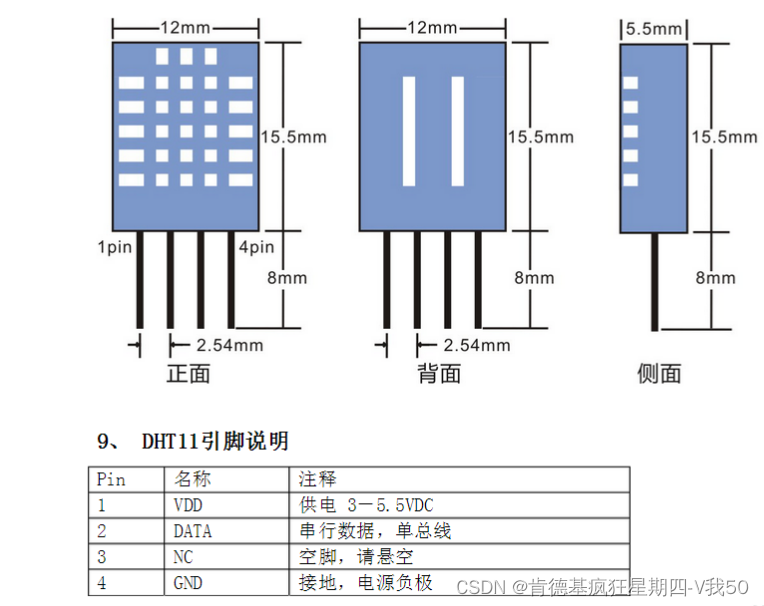
注:VDD接5v.
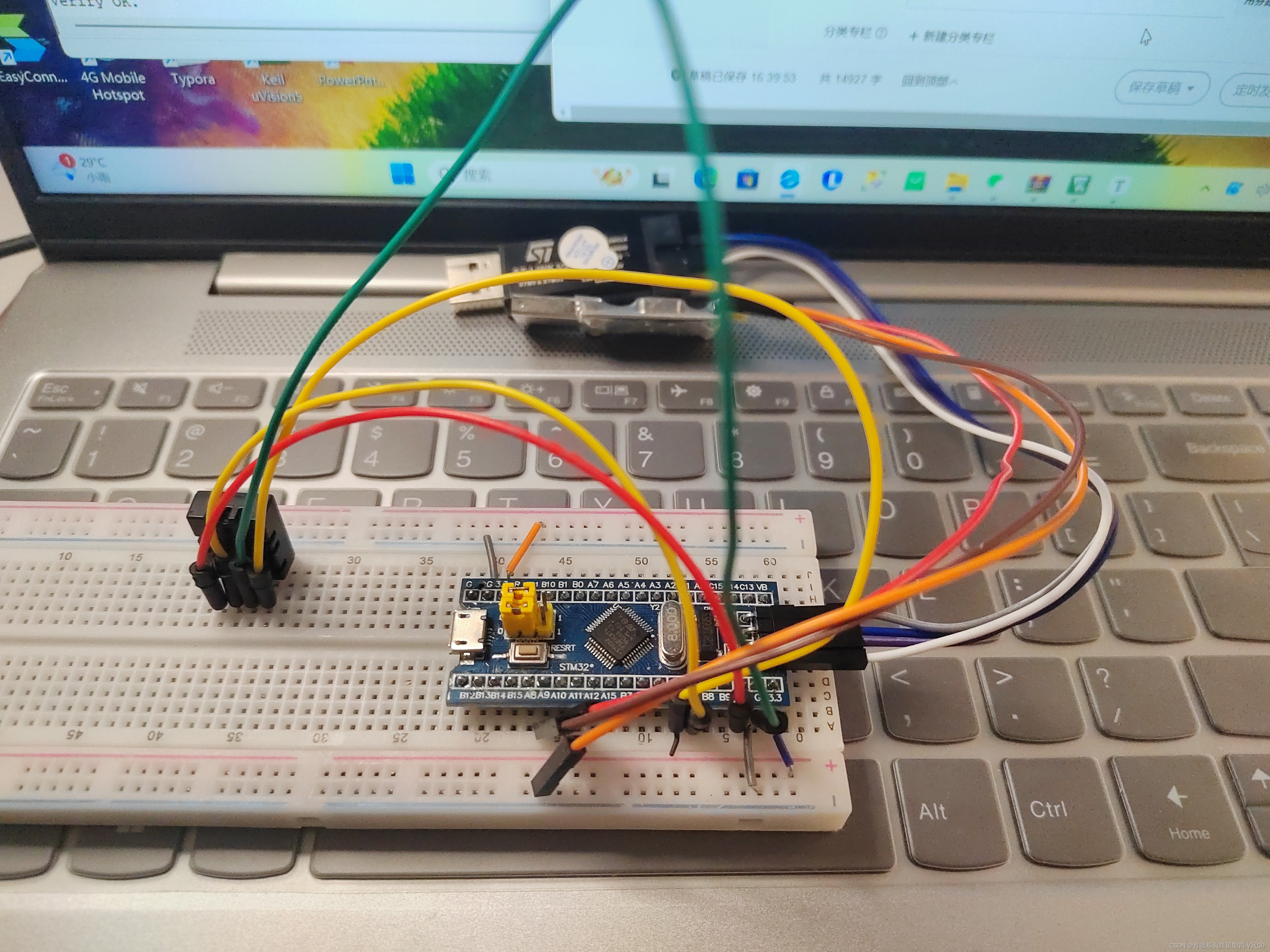
4.实验效果
注:若串口为显示信息,可尝试将STlink拔掉后重新插入再打开串口。

项目代码:
STM32温湿度采集项目包和AHT20: 存放STM32温湿度采集的KEil项目包和AHT20代码
参考博客:
I2C总线通信协议及实操stm32通过I2C实现温湿度(AHT20)采集_stm32 aht20-CSDN博客
使用STM32F103完成基于I2C协议的AHT20温湿度传感器的数据采集-CSDN博客
I2C通信协议详解和通信流程分析_i2c协议-CSDN博客
软件I2C与硬件I2C的区别_软件i2c和硬件i2c-CSDN博客
